When you have a platform, you will find that the most interesting stuff comes from people you don not expect. For example, in San Francisco we have the real time bus app, a lot of cities do. A bunch of citizens looked at the real time bus app and said, “You know, the people who work in Muni...” We actually had an intern from Muni come in, and she pointed out that within Muni, when they want to understand if a bus is running late or a bus is broken, they use walkie-talkies. They’re not plugged in, they don’t use the data and an intern led program over a weekend built a new system, which is a real time trouble ticket system that will tell you where a Muni bus is broken.
It was the first time that the IT people in the city saw an IT system being built by citizens who basically thought, “It’s stupid not to have one.” The press wrote an article and said, “Citizens build an app over the weekend,” the head of transit wasn’t sure whether to be thrilled or a little bit embarrassed because the citizens did it.
It was the first time that the IT people in the city saw an IT system being built by citizens who basically thought, “It’s stupid not to have one.” The press wrote an article and said, “Citizens build an app over the weekend,” the head of transit wasn’t sure whether to be thrilled or a little bit embarrassed because the citizens did it.
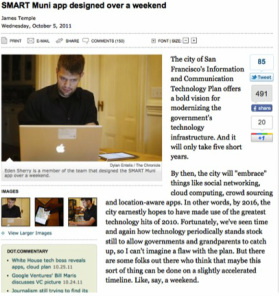
Then we had a debate with all of the mayor candidates. The candidates said, “We love it.” It never got implemented, and nine months later, the New York Times writes an article that says, “San Francisco, king of innovation, can’t implement it.” It took a week for the Chamber of Commerce to fund it, and now it’s become a core system.
The point of this is that you really can rely on this stuff. Now it’s become a major part of how Muni works. We regularly go out to citizens and have them source ideas and figure out what should get built.
If we summarize this, there are a lot of Internet values that are showing up. The point is less that we use the Internet, and more that there is a way of thinking in the Internet world where it’s less planning and more doing. You prototype, you fail quickly and see what works. It’s not a natural first response on the part of cities to think this way, but this is how the whole class of young people and entrepreneurs think, and it’s a real value in contribution.
The point of this is that you really can rely on this stuff. Now it’s become a major part of how Muni works. We regularly go out to citizens and have them source ideas and figure out what should get built.
If we summarize this, there are a lot of Internet values that are showing up. The point is less that we use the Internet, and more that there is a way of thinking in the Internet world where it’s less planning and more doing. You prototype, you fail quickly and see what works. It’s not a natural first response on the part of cities to think this way, but this is how the whole class of young people and entrepreneurs think, and it’s a real value in contribution.
This whole ethos came out of an interesting moment. In the 1960s, there was a moment when the counter-culture, sex drugs and rock ‘n’ roll, encountered the microprocessor at Stanford University. It was out of that ferment that the personal computer went on this liberation. The PC was about liberating and self-expression. Computing wasn’t about that before. Those same values are with us today. I think one of the fundamental differences is, in the 1960s, we protested the establishment. Today, we write to its application programming interface. That is a fundamental difference.One of the key things that happened in the early computer days is the rest of the computing establishment didn’t take it seriously, didn’t know what hit them, didn’t think it was very serious.
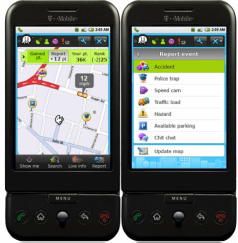
I would like to wrap up by asking the question,
"is it possible that some of the most valuable smart city companies out there, and the things that bring the greatest capital to our cities, may not be coming from smart city companies at all?"
For example, Airbnb, which is a company that allows people to rent out excess rooms in their house. On the one hand, it’s just a utility; yet it was Airbnb during Hurricane Sandy that provided places for people to stay in New York. Now Airbnb has a new feature that lets you discover neighborhoods, and actually gets both locals and non-locals to discover and use other parts of town. If you think about it, this is an entrepreneur who built a business around sharing technology, but it’s really a civic innovation app, because it’s about how to use a city better.
Another example is Waze, a traffic app. It uses crowd-sourcing, so as you drive around, you give Waze permission to know where you are, and that creates traffic information.
"is it possible that some of the most valuable smart city companies out there, and the things that bring the greatest capital to our cities, may not be coming from smart city companies at all?"
For example, Airbnb, which is a company that allows people to rent out excess rooms in their house. On the one hand, it’s just a utility; yet it was Airbnb during Hurricane Sandy that provided places for people to stay in New York. Now Airbnb has a new feature that lets you discover neighborhoods, and actually gets both locals and non-locals to discover and use other parts of town. If you think about it, this is an entrepreneur who built a business around sharing technology, but it’s really a civic innovation app, because it’s about how to use a city better.
Another example is Waze, a traffic app. It uses crowd-sourcing, so as you drive around, you give Waze permission to know where you are, and that creates traffic information.
On November 3rd in New Jersey we had a really bad hurricane, the state flooded and by that afternoon it became clear that there were five-hour gas lines.
I was scheduled to have lunch in San Francisco with the White House innovation fellow handling energy. He basically said, “Our lunch is interrupted, we have to go figure out where the gas stations are and how people are going to get helped. There’s no power, and we’ve got FEMA, government gas trucks, we don’t know where to send them.” Our first thought was, well, mobile carriers know where you are, because they have all those digital traces. If we could actually look at the AT&T and Verizon traces, map them over gas stations, we could see where the line was going up. The White House had tried that. For two days it was nothing but lawyers and lobbyists, every reason we couldn’t do it.
At about 3:00 in the afternoon, I said, “Well, let’s call up Waze.” They might actually know where the gas stations are. I sent and email to my friend Diana at Waze, basically saying, “The White House’s big headache today is that there are these big gas lanes, the carriers won’t cooperate because of privacy and policy, which brings us to you. The White House and the Energy Department would like to know, do you have enough customers in New Jersey to bring insight here? They need to find out where the gas lines are.”
At about 3:00 in the afternoon, I said, “Well, let’s call up Waze.” They might actually know where the gas stations are. I sent and email to my friend Diana at Waze, basically saying, “The White House’s big headache today is that there are these big gas lanes, the carriers won’t cooperate because of privacy and policy, which brings us to you. The White House and the Energy Department would like to know, do you have enough customers in New Jersey to bring insight here? They need to find out where the gas lines are.”

Now it turned out that by the times Ways looked at this, their customers had already been building the solution. By 10:00 that night they were able to say, 280 gas stations are open, and they were able to use this one resource very strategically.
When we talk about the history of computing you could almost say the history of computing is the story of liberation from closed systems that did one thing to very open systems that enfranchise a lot of people. As the city becomes a platform, there’s a really powerful expression of that there, which is why we are building an architecture that cannot help but drive participation. There is broad-base adoption of technology and a whole youth culture that uses all of this stuff.
That’s why we say when you think about the city as a platform, it’s something that nobody can own, everybody can use, and anyone can improve. When you think of the union between the strategic resources in a city and their vendors that do a lot of the heavy lifting, citizens as both inputs but real users and drivers of the platform, it’s probably a golden era of civic participation.
"The city really is our next great platform."
When we talk about the history of computing you could almost say the history of computing is the story of liberation from closed systems that did one thing to very open systems that enfranchise a lot of people. As the city becomes a platform, there’s a really powerful expression of that there, which is why we are building an architecture that cannot help but drive participation. There is broad-base adoption of technology and a whole youth culture that uses all of this stuff.
That’s why we say when you think about the city as a platform, it’s something that nobody can own, everybody can use, and anyone can improve. When you think of the union between the strategic resources in a city and their vendors that do a lot of the heavy lifting, citizens as both inputs but real users and drivers of the platform, it’s probably a golden era of civic participation.
"The city really is our next great platform."
Video

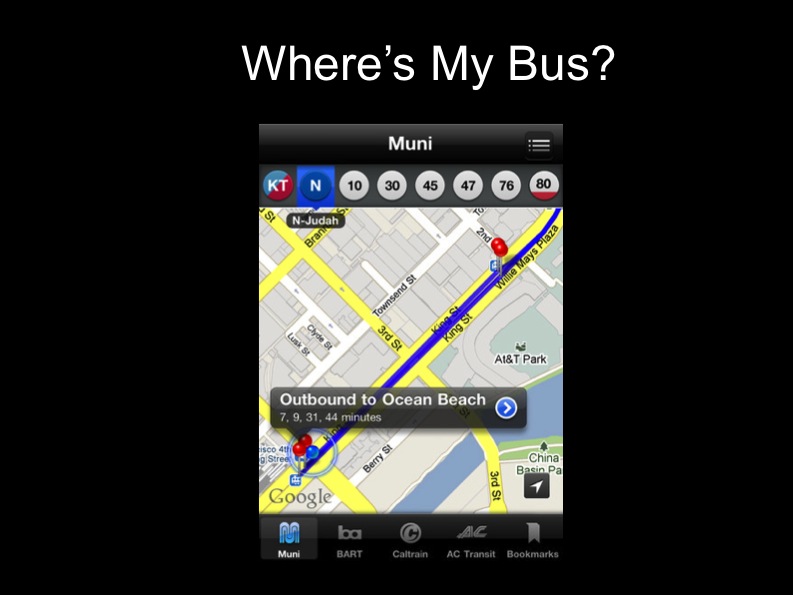
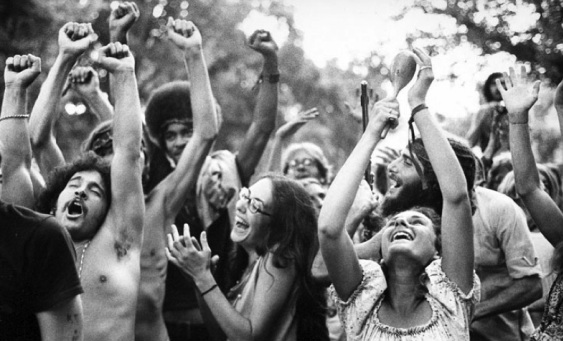
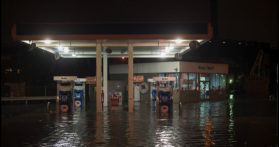

 RSS Feed
RSS Feed
